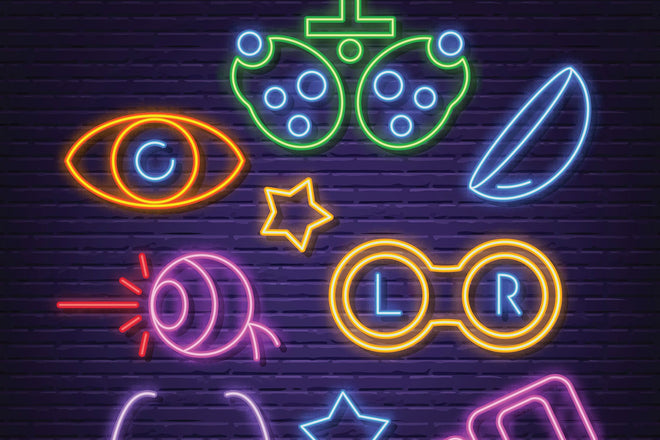Presbyopia is a natural loss of near-focusing ability as we age. The effects of presbyopia are noticeable around the age of 40. Most people notice that they can’t see small print clearly and have to hold reading material away from their faces to bring it into focus.
Since the decrease in near vision is gradual, people are surprised that they can no longer see printed material and require the use of an aide such as readers, bifocals, or magnifiers.
Causes of Presbyopia
For your brain to form an image, the cornea and lens in your eye need to focus the light reflected from objects. The cornea is the clear dome on the surface of your eye, while the lens is the transparent structure covering your eye.
Both of these structures work with your brain to control what you see. They bend and refract light that enters your eye to focus the image on the retina located in the back wall of your eye.
When presbyopia occurs, the lens of your eye hardens and becomes less flexible. As the lens becomes less elastic, it can no longer adjust its shape to focus on up-close images resulting in them appearing out of focus.
Presbyopia Symptoms
Since presbyopia develops gradually, you may notice the following symptoms worsen over time:
- Having to hold reading material farther away from your face to be able to see the small print
- Eye strain, headaches, or watery eyes, after reading or doing close up work
- Blurred vision when reading from an average distance
- Having trouble reading everyday print materials
Risk Factors
There are a few factors that make you more prone to developing presbyopia, including:
- Age: Age is the most significant factor of presbyopia.
- Drugs: Drugs like antidepressants and antihistamines are associated with the early development of presbyopia
- Certain Medical Conditions: Certain medical conditions such as diabetes and cardiovascular diseases can increase your risk of premature presbyopia (those under the age of 40)
5 Ways to Treat Presbyopia
Today, we’ll talk about 5 ways you can mitigate the effects of presbyopia—so you can better get through your working and personal life.
1 | Reading Glasses
Reading glasses offer the most comfortable, practical, and inexpensive way to accommodate your near vision.
Since their only purpose is to provide a clear vision up close, all you have to do is choose the right power to fit your needs. Readers are available without a prescription, so you can purchase them from your favorite store or online providers for good selection and price.
2 | Bifocals and Progressive Lenses
Bifocals are divided into two areas: the top part for distance vision and the bottom portion for up close or reading. In the case of non-prescription readers, the upper distance portion of the lens is clear. They’re simple to use since there is a “line” separating the distance and near portions. So, all you have to do is look straight ahead for viewing distance and look down for the reading part
However, most computer screens and laptops are in the intermediate range, which bifocals do not cover.
Progressive lenses offer a smooth transition of lens strengths for all depths of field: distance, near, and intermediate. This style of glasses features an intermediate zone to view your favorite digital device or desktop PC. They are more versatile than bifocals since they offer more zones of clarity to cover most of your visual needs, from driving your car to looking at your computer and to reading texts on your cell phone.
Whether you have a distance prescription or have no distance prescription and just want to keep your eyewear on your face all day, bifocals and progressive lenses are the appropriate choices.
Whether it is readers, bifocals, or progressive lenses, you can’t go wrong—these are all excellent options for accommodating presbyopia. If you’re not sure which one is right for you, start by trying one of them out and seeing how it feels.
3 | Contact Lenses for Presbyopia
If you already wear contact lenses, all you need to do is add a pair of reading glasses at the appropriate power. While you’re wearing your contact lenses, you can try out different reading glasses’ strengths to determine which is the most suitable for your close vision tasks.
Monovision contacts are another option – that means one eye focused for distance, and the other eye focused for near. Or, try multifocal contact lenses with different zones of power for distance and close vision dependent on the wearer’s pupil size. However, both of these options require a potentially lengthy adaptation time, as well as the increased cost of fitting the contact lenses by your eye doctor and the cost of the contact lenses themselves.
If eyeglasses or contact lenses are unappealing choices, surgical options are available to people suffering from presbyopia.
4 | Corneal Inlay
The most interesting surgical procedure is the implantation of a corneal inlay. An inlay is an FDA approved medical device inserted in the cornea (front of the eye) of the non-dominant eye, which increases the depth of focus. Even though this potentially reduces the need for reading glasses or contact lenses, it is not a perfect solution and may need reading glasses in some cases.
Because one eye is geared for distance and the other eye for near, the vision’s quality may not be as clear. Also, depth perception may be affected since you need both eyes to focus on the same thing. Glare in night vision may increase, too, since both eyes are not working perfectly together.
5 | Lens Exchange Surgery
Another up-and-coming refractive surgery involves replacing your natural lens (the lens is in the back of the colored part of the eye) with a multifocal lens implant. A multifocal lens is a lens that has different zones of clarity for distance and near viewing. This is similar to cataract surgery, where the cataract is extracted, and a lens is inserted in its place.
However, because the lens has a multifocal nature, the vision’s quality may not be crystal clear and prone to aberration and distortion.
With both the corneal inlay and lens exchange surgery, there is no guarantee that it will achieve the desired result of freedom from needing readers or bifocals.
Plus, both procedures are cost-prohibitive and not covered by insurance since insurance companies consider it as elective surgery.
As such, surgical intervention to correct presbyopia should be considered a secondary option to readers, bifocals, and progressive lenses.
When to See a Doctor for Presbyopia
If blurry, close-up vision prevents you from enjoying reading or doing close-up work, seeing an eye doctor can significantly improve your quality of life. An eye doctor can provide guidance and recommend the perfect solution for you. That said, seek immediate medical care if you are experiencing the following symptoms:
- Double vision
- Flashes of light, black spots, or halos around lights
- Sudden hazy or blurry vision
- Sudden loss of vision in one or both eyes, with or without pain
The Final Word
There are different ways to treat and cope with Presbyopia. They vary from practical and straightforward, too costly and a bit risky. Ultimately, it all depends on your preference for correcting your diminishing ability to see up close.
Your situation is unique to you, as is what you consider essential to your particular lifestyle. I hope this article helps you in making the most appropriate choice.





